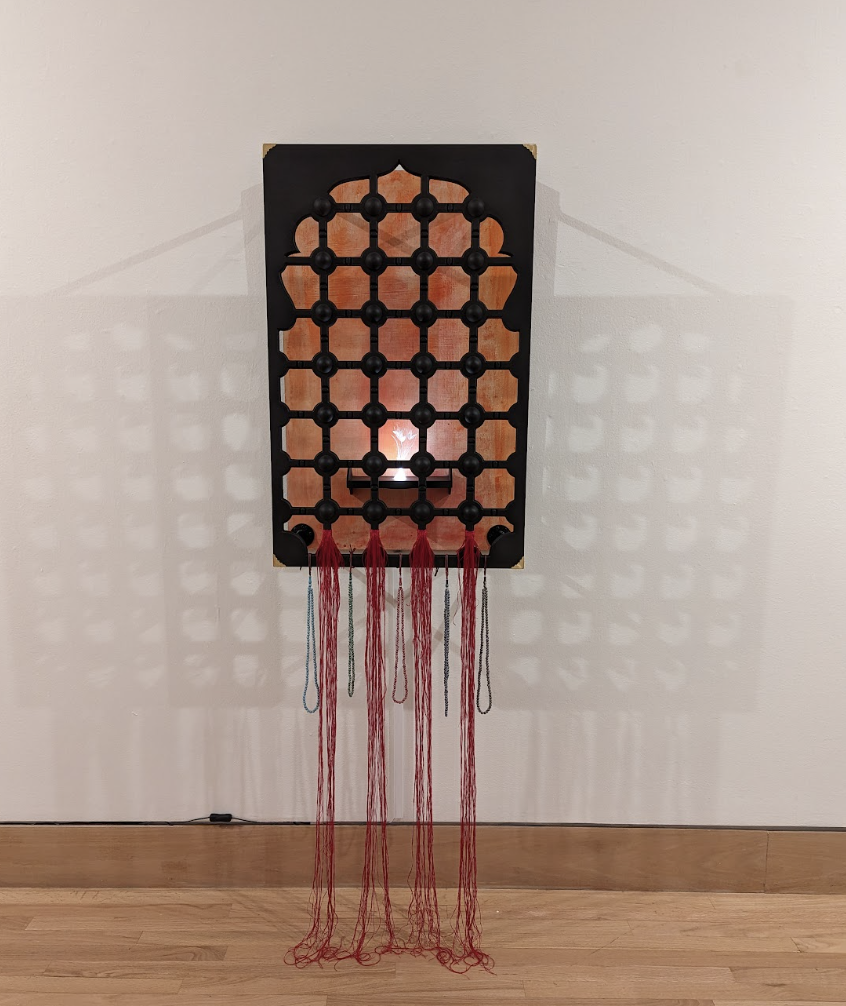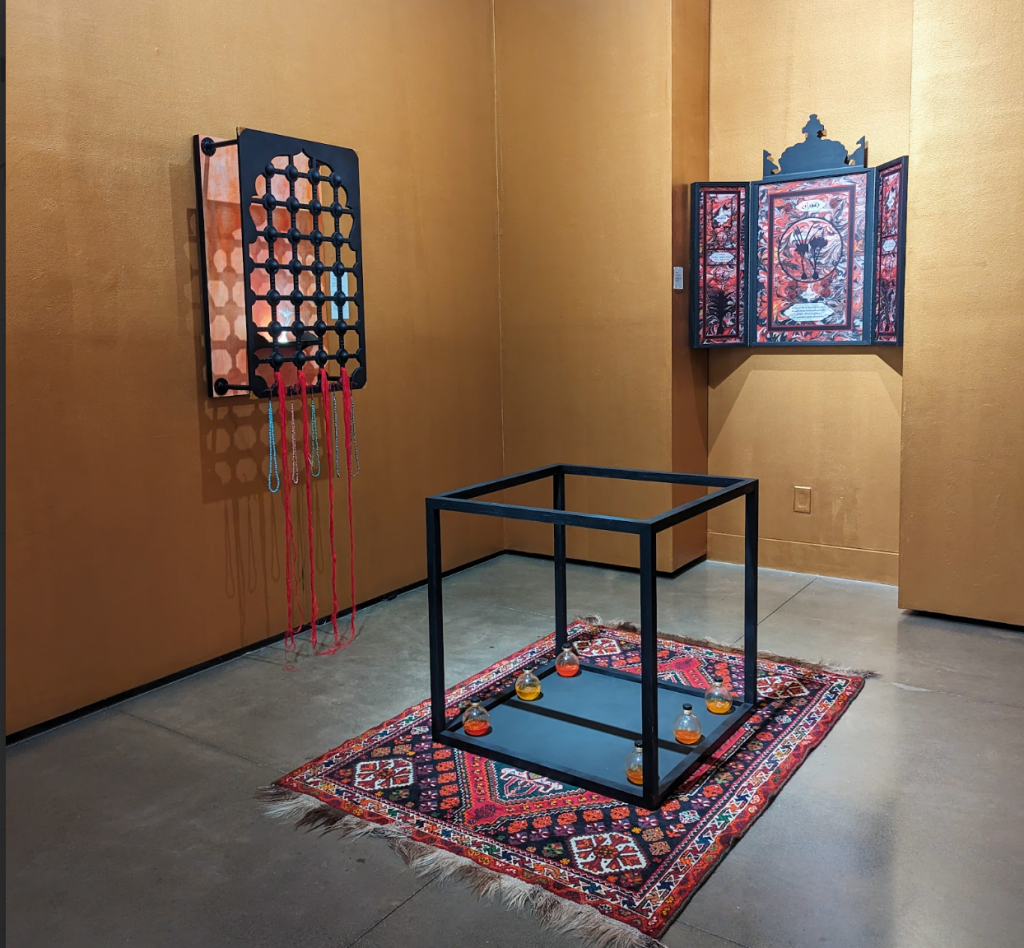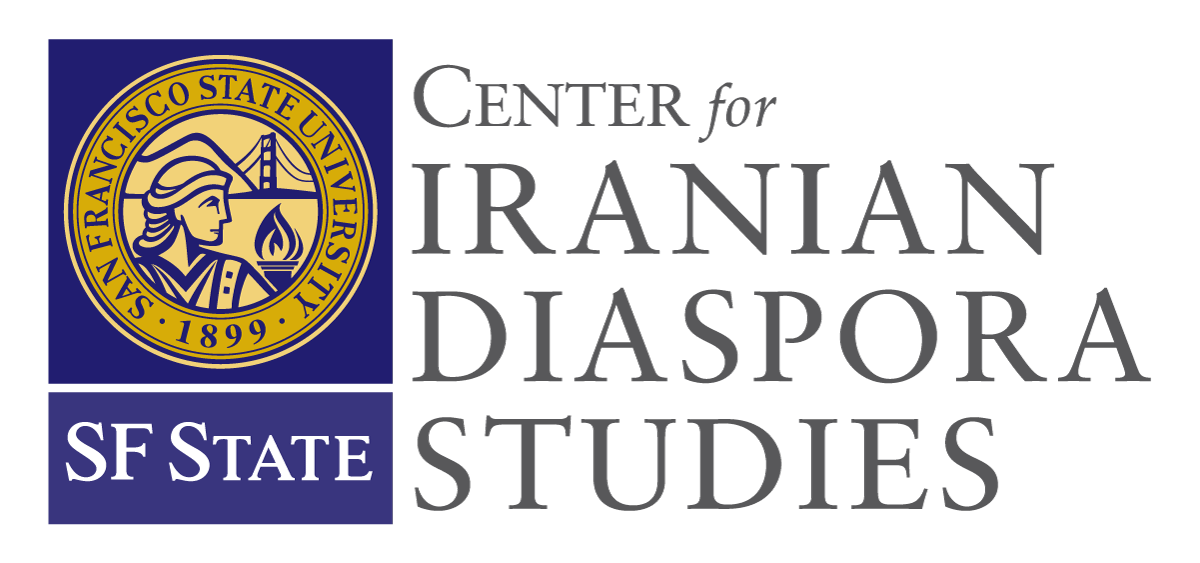By Persis Karim, Center Director
“Saffron is a symbol of the contemporary economic and agricultural challenges that have been convoluted with ongoing political issues under the theocracy in Iran.”
– caption from Pantea Karimi’s exhibit at the Euphrat Museum of Art, Cupertino
California-based visual artist Pantea Karimi has long been fascinated with the intersection between art and science. Her work spans more than a decade of exploration of the great scientific minds of the medieval Islamic period from Iran and throughout the Muslim world, in prints, installations, sculptures, and other visual media. But nothing has caught her attention quite like the saffron crocus. Her most recent work, Saffron, Saint of Spices now part of a show at the Euphrat Museum of Art at De Anza College in Cupertino, California, pays homage to the role of saffron, its properties and mystical beauty, as well as the ways that the saffron industry in Iran has built on the labor of women. Karimi’s interest in saffron, and more generally in plants and herbs, grows out of her childhood in the famously poetic city of Shiraz, in southern Iran, where she spent countless hours with her family walking and picnicking in Shiraz’s beautiful gardens, especially the famous historic Eram Garden that is located on the Khoshk River. “I loved all the beautiful plants preserved in this garden, but I was also intrigued by plants and herbs because my grandmother was an herbalist and had knowledge of and prepared many herbal remedies for our family,” she says. In addition to the plants and the elaborate landscaping of the Eram Garden, Karimi says that the geometric and highly mathematical nature of the historic gardens influenced her attraction to the ways that science, math, and philosophy, undergird much of the art produced in the medieval period. Because her father is a retired architect and mathematician, she says she had a natural curiosity for the ways that art and science have been organically intertwined in Iranian arts and “embedded into the psyche” of Iranians over many centuries. It was these early childhood memories, and the influence of her parents and grandmother, that eventually led her to want to explore the role of plants and herbs in the culture, cuisine, and medicine of Iran. During the summer of 2021, she applied for and received a one-year residency at the University of California, San Francisco Library (largely a medical school and scientific research campus of the UC system) where she plunged into a year-long research project reading and studying UCSF’s Library botanical archives. “My attention was on illustrated books, of which many had been produced at the height of the late medieval and early modern periods. They contained volumes of information, beautiful illustrations, as well as explanations of the properties and uses of many of these plants for medical purposes,” she says. Karimi was particularly interested in some of the earliest manuscripts contained in the USCF Library archives that mention the saffron crocus, the flower from which the saffron spice is derived. The books she found in the archives contained many illustrations, and what she noticed, in particular, was the emphasis on the “artistic” interpretation of saffron, which seemed to depart from the more scientifically oriented explanations of other plants and herbs.

“What I learned is that beyond the beautiful color, the exquisite aroma of this spice, and its pervasiveness in much of the cuisine of the Persianate world, saffron was used as an anti-depressant, as well as in reducing anxiety and improving cognitive abilities,” says Karimi. “I found this fascinating because I knew saffron as the spice that permeated our Iranian cuisine—used in tea, and savory and sweet dishes, but also cherished for its color, but to learn about its importance in medicine made me feel I had something to add as an artist, and especially as an Iranian-born one. After my residency, I thought of paying homage to the saffron crocus through a series of 2- and 3-dimensional pieces that resulted in a solo exhibit at the Triton Museum of Art in Santa Clara, California, in early 2023.” This year, Karimi’s work traveled to Sacred Terrain, a botanical exhibition, at the Euphrat Museum of Art, displayed in a temple-like space that is painted gold. Several of her pieces illustrate the “saintliness” of saffron by drawing on its miraculous and medicinal qualities, by showing how this unique purple flower which blooms for a very short period in the autumn has multiple uses, such as culinary, cosmetics and medicinal. “By drawing attention to the flower’s beauty and its miraculous qualities, I decided to bring its 16th-century depiction into a contemporary context,” says Karimi. One of the pieces in the exhibit is a life-size saffron crocus sculpture after a 16th-century image of the flower that she produced in collaboration with the UCSF Library Makers Lab in 2022 during her residency. Other pieces in the exhibit are made after historic religious objects such as triptychs, shrines and Saqqaakhanaa – the (religious) water fountain. Traditionally visitors would leave votive items like flags or locks on the grided exterior of the Saqqaakhanaa. On one of the shrine sculptures, “Sacred Threads,” Karimi has hand-tied four hundred and fifty votive red threads. They are symbols for healing wishes and the four hundred and fifty saffron threads that make up the 1-gram saffron spice. The illuminated 3-D saffron crocus flower sculpture is shown on this object as a “saint.” The other object in the show is a triptych titled: “A Divine Allegory,” which is inspired by the 18th-century Muslim triptych, hilya-i-sherif. Karimi replicated the design but replaced the botanical vegetation, and the religious texts with saffron crocus archival images and its healing properties, described in the Persian script.

But Karimi’s exhibit also draws on another lesser-known fact about saffron: the incredibly difficult circumstances under which the flowers are harvested in Northern Iran, largely by women. The majority of the world’s saffron is still today produced in Khorasan in the northeast of Iran, which is cold and semi-arid during the autumn months, says Karimi, and for that reason, she says she had to bring the landscape and labor of saffron cultivation into her exhibit. “The flower blooms in late October/early November just before winter descends over a very short period,” says Karimi. “Each flower contains three stigmas, and 150,000 flowers must be handpicked by women to produce 450,000 stigmas for 1 kilogram of the spice.” Because this harvesting is so compressed into such a short time, women from this region of Iran work under difficult and physically challenging circumstances. “These women are not paid well, they must abide by the Islamic dress code while in the field, and they usually don’t wear gloves due to the delicate nature of the flowers,” says Karimi. Because the flowers are so low to the ground—usually between no more than 6-12 inches that grow from a bulb, women must sit in the fields and harvest intensely in the colder hours of the morning. Karimi says that women have been doing this labor for centuries and are considered the ideal workers for several reasons: they are “temporary” laborers and take on this work to supplement their family income and are thought to be better suited for this work because they are patient and can carefully pluck the stigma from the flowers. The harvesting, according to Karimi, is done over a period of weeks, and the scent of saffron is intense inside the factory where the spice is processed and packaged. Karimi, while still a student in art school in Iran designed packaging for a saffron producer, and noted how overwhelming the scent of saffron was inside one of the packaging factories she visited. While Karimi wants to pay homage to the medicinal qualities of saffron, she knows that most Western consumers do not know the dark underside of the saffron industry. “I want to show the beauty and mystery of this flower and the spice it produces, but I also want to show the hardships and suffering that accompany it,” Karimi says. This, she notes, includes the back and body injuries of the women working long hours kneeling and sitting in cold climates, and severe allergies that they may develop from overexposure to the scent of saffron, especially in enclosed spaces. But also, the economic injustice that has deprived saffron workers and producers of a fair price on the global market.

“It is a crop that has suffered from both climate change and international sanctions on Iran,” says Karimi. “Drought and rising temperatures are drying up Iran’s valuable saffron harvests and causing world prices to rise dramatically,” according to British publication Geographical.
Ninety percent of the world’s saffron is cultivated in Iran and the majority of which is produced in Khorasan province in northeast Iran, according to a BBC report, but Karimi adds, “because of the severity of the sanctions, Iran often cannot sell saffron directly on the global market and must ship it to secondary countries like Morocco or Spain, where it is then relabeled for sale to the West. “Most of the saffron you can buy in stores has removed the country of origin from the label,” Karimi adds. And this phenomenon contributes to the large middlemen chain that reduces the profits on the sale of saffron, which directly impacts the women who labor to pick the saffron crocus.

For Karimi, the importance of telling the whole story of saffron—its beauty, its color, and its longstanding lore in the botanical archives is important—
But she also wants its “saintliness” to come from its healing attributes and the hardship and suffering associated with its production for global consumption.
You can view Karimi’s work at the Euphrat Museum of Art at De Anza College, Cupertino, CA, until March 23rd, 2024. You can learn more about Karimi’s work at: panteakarimi.com.
Captions from exhibit:
“Often saffron labeled as Spanish or Moroccan is actually of Iranian origin.” Bon Appétit, 2020
“To get around sanctions, Iranian saffron traders often use non-Iranian middlemen and
opaque supply chains.” The Economist, 2021
All photos courtesy of Pantea Karimi.
Featured image: Artist Pantea Karimi perusing the University of California San Francisco Library which includes medicinal botanical books from the late medieval and early modern periods.
